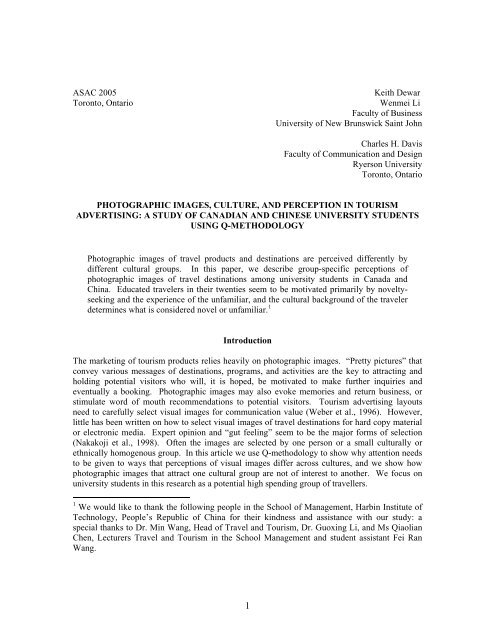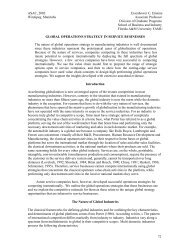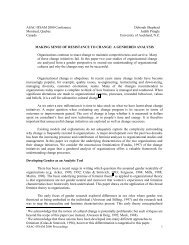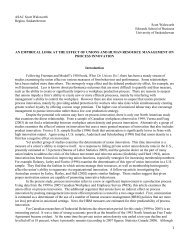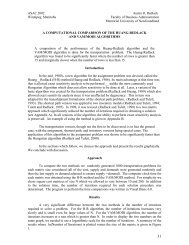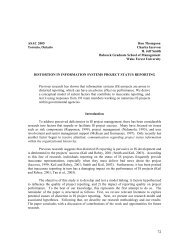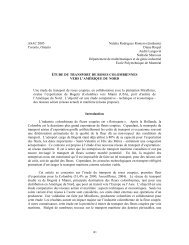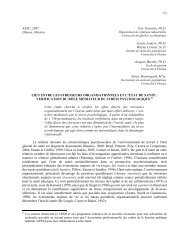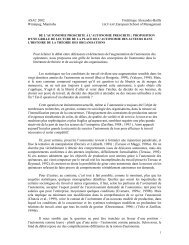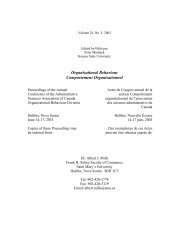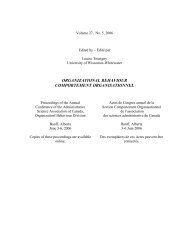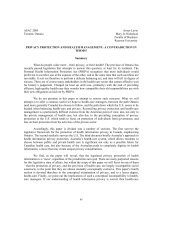Photographic Images, Culture, And Perception In Tourism ...
Photographic Images, Culture, And Perception In Tourism ...
Photographic Images, Culture, And Perception In Tourism ...
Create successful ePaper yourself
Turn your PDF publications into a flip-book with our unique Google optimized e-Paper software.
ASAC 2005Toronto, OntarioKeith DewarWenmei LiFaculty of BusinessUniversity of New Brunswick Saint JohnCharles H. DavisFaculty of Communication and DesignRyerson UniversityToronto, OntarioPHOTOGRAPHIC IMAGES, CULTURE, AND PERCEPTION IN TOURISMADVERTISING: A STUDY OF CANADIAN AND CHINESE UNIVERSITY STUDENTSUSING Q-METHODOLOGY<strong>Photographic</strong> images of travel products and destinations are perceived differently bydifferent cultural groups. <strong>In</strong> this paper, we describe group-specific perceptions ofphotographic images of travel destinations among university students in Canada andChina. Educated travelers in their twenties seem to be motivated primarily by noveltyseekingand the experience of the unfamiliar, and the cultural background of the travelerdetermines what is considered novel or unfamiliar. 1<strong>In</strong>troductionThe marketing of tourism products relies heavily on photographic images. “Pretty pictures” thatconvey various messages of destinations, programs, and activities are the key to attracting andholding potential visitors who will, it is hoped, be motivated to make further inquiries andeventually a booking. <strong>Photographic</strong> images may also evoke memories and return business, orstimulate word of mouth recommendations to potential visitors. <strong>Tourism</strong> advertising layoutsneed to carefully select visual images for communication value (Weber et al., 1996). However,little has been written on how to select visual images of travel destinations for hard copy materialor electronic media. Expert opinion and “gut feeling” seem to be the major forms of selection(Nakakoji et al., 1998). Often the images are selected by one person or a small culturally orethnically homogenous group. <strong>In</strong> this article we use Q-methodology to show why attention needsto be given to ways that perceptions of visual images differ across cultures, and we show howphotographic images that attract one cultural group are not of interest to another. We focus onuniversity students in this research as a potential high spending group of travellers.1 We would like to thank the following people in the School of Management, Harbin <strong>In</strong>stitute ofTechnology, People’s Republic of China for their kindness and assistance with our study: aspecial thanks to Dr. Min Wang, Head of Travel and <strong>Tourism</strong>, Dr. Guoxing Li, and Ms QiaolianChen, Lecturers Travel and <strong>Tourism</strong> in the School Management and student assistant Fei RanWang.1
A photograph is a complex text that can be read many ways. It is surrounded by a historical,aesthetic, and cultural frame of reference as well as by an entire “set of relationships andmeanings relating to the photographer and the point at which the image was made... The image isas much a reflection of the 'I' of the photographer as it is of the 'eye' of the camera...” (Clarke,1997: 27 and 33). <strong>Images</strong> are interpreted through cultural lenses. This implies that we expectdifferences in how individuals see, select, and read images. Cultural backgrounds shapeexpectations and travel experiences. The present research suggests that culture and prior travelexperiences are strong influencers of the way young people view images of travel destinations.Visual images in tourism and travel marketingThe relative paucity of research literature on methods of selection of photos for presentation tothe customer is a problem for tourism marketers who wish to prepare effective presentationmaterials. The value of proper images and general layout of promotional material has receivedattention (Dilley, 1986; Johnston and Tieh, 1985). A few authors have discussed visualrepresentation of destinations in tourism promotional literature (Henderson, 2001; Jenkins, 2003),and a small literature investigates perception of visual images of destinations in a historic NorthAmerican context (Colpitts, 1998; Hoelscher, 1998; Wyckroff & Dilsaver, 1997). Much existingliterature on image perception concerns itself with ethical and stereotypical imaging ofdestinations . Visitor-taken images are also analyzed to explain the travel experience as a type ofartistic expression (Garlick, 2002) or to assess and interpret travel experiences (Groves andTimothy, 2001). Yu shows that landscape preference by tourists is significantly influenced by thecultural backgrounds (Yu, 1995).Another line of empirical research samples the visitor or potential visitor to describe perceptionsof specific visual depictions of travel destinations or activities. Hem, Iversen & Gronhaug.(1990) report results of research on a sample of potential international visitors from severalcountries who evaluated photos of Norwegian nature-based destinations. Factor analysis of datarevealed two underlying dimensions, which were termed "positive feelings" and "danger.” Thedimensions were related to the strength of the intention to visit. Gender is known to have amoderating effect on photo selection (ibid.). Fairweather and Swaffield (2001) use photographsof landscapes in the Kaikoura area of New Zealand to show “the varied ways in which Kaikourais experienced as a tourist destination,” finding evidence of “subtle but significant distinctionsbetween the experiences sought and appreciated by different visitor groups” (p. 219). Davis(2004) and Davis and Khare (2002) use visitors’ perceptions of photographic travel images toidentify segments in the market for travel preferences for purposes of tourism productdevelopment.This paper explores ways that various cultural groups view similar images drawn from electronictravel advertising and related literature. We hypothesize that different cultural groups differ intheir preferences for travel-related photographic images. Although the literature on cross-culturalperception is considerable, little work has been done on how this relates to tourism and travel andthe way that images are presented. Little research exists regarding pre-selection of images for use2
in promotion and marketing material. The issue of selection is not made easier by the fact thattourism is very much an international and cross-cultural business. <strong>Images</strong> must match a specificcultural or ethnic group’s perceptions and preferences closely enough to convey the intendedmeaning. The major problem for the selector of images for marketing and advertising in tourismrevolves around four main issues: quality of the image; relation of text to image; the story theimage tells; and matching the right story to the right audience. With the great increase ininternational travel and the potential for outbound travel from Asian countries (particularly <strong>In</strong>diaand China), marketers must re-examine the way images are chosen and how they are used. Thispaper explores how three different groups perceive photographic images of destinations. We findthat People’s Republic of China (PRC) university students read destination images differentlythan PRC students who have been exposed to North American culture through study in aCanadian university, and that both groups differ from Western university students in theirreferences for photographic images. Further, we show that Q-methodology provides a useful,relatively easy method for identifying and selecting appropriate images for promotional andmarketing material. We refer to the PRC students in Canada as “acculturated” in the sense thatacculturation is “the processes by which individuals, families, communities, and societies react tointer-cultural contact” (Rumin 2003). <strong>In</strong>creased globalization makes the study of acculturationessential to understanding travel motivation and traveler decision-making.Method<strong>In</strong> this paper we use Q-methodology to provide insights into the travel image preferences ofChinese and Western university students. Q-methodology is an exploratory approach toobservation and theory development. It combines qualitative and quantitative analysis to providea systematic and rigorous means of objectively describing human subjectivity (Brown 1996). Q-methodology often leads to surprising new observations that require explanation (results of thepresent research are a good example). For this reason Q is considered to be an instrument ofabductive inference, taking its place along deductive and inductive approaches to knowledge.Q-methodology has been applied in many disciplines such as political science, marketing,psychology, sociology, public policy, marketing, and health care. 2 A number of researchers haveused Q-methodology in landscape perception research (see the discussion in Fairweather andSwaffield 2001). However, the use of Q-sorted images in tourism destination research isrelatively novel. For example, Fairweather and Swaffield (2001) found that families prefer thecoastal experience in Kaikoura, New Zealand, and through using photographs of landscapes andthe Q-method Davis and Khare (2002) discovered that outdoors exploring and coastalenvironment observation are primary market segments for summer visitors to the Bay of Fundyregion, Canada.<strong>In</strong> Q-method, respondents rank order items – in this case, photographs of tourism activities –according to a specific instruction – in this case, from most to least interesting. The resulting2 For full descriptions of the method and examples of its use see McKeown and Thomas (1988),Brown (1980), or the journal Operant Subjectivity.3
matrix is then factor analyzed. We used a commercial Q-methodology software package, PCQfor Windows, for purposes of data analysis. This software performs factor analysis and varimaxas well as graphical rotation of factors.Q method requires the development of a “concourse” of stimulus items. We collectedphotographic images on the <strong>In</strong>ternet in seven categories of tourism: adventure; cultural;nature/ecotourism; urban; rural; heritage; and special interest and miscellaneous tourism topics.Eastern and Western images were included in approximately equal numbers. Unclear images andones that were not easily perceptible when printed on 3”x 5” cards were discarded. Over onehundred images were reviewed by a team of three, a Chinese graduate student, a Chinese researchassociate, and an English speaking Canadian. An initial group of 41 images was selected for apilot study involving twenty university students (ten English-speaking Canadians and ten studentsfrom PRC who had been in Canada between one and five years). On the basis of the pilot study,several small changes were made in the deck of images and the number of images was reduced to34. <strong>Images</strong> are listed in Table 1. Space constraints do not permit reproduction of images here.Three separate groups of students participated in the full study: 27 Canadian students withEnglish as a first language (E), 27 students from the Harbin <strong>In</strong>stitute of Technology’s School ofManagement, Faculty of Business (CH), and 27 Mandarin speaking students from the PRC whohad been studying in Canada for one to three years (C). We consider Chinese students in Canadato be “acculturated” and hypothesized that they would express different preferences for travelimages than Canadians and Chinese students in China. Ninety percent of the participants inCanada were undergraduates from the Faculty of Business and ten percent were from otherfaculties. The students from Harbin were from third-year classes. All of the participants were intheir early or mid twenties. Approximately equal numbers of students of each genderparticipated.Approximately half the respondents in Canada were recruited through a summer school businessclass in which volunteers were asked to participate in the study. The others were approached in apopular meeting spot on campus and invited to participate. Fewer than five percent of inviteesdeclined to participate. Once the students had consented, they were presented with a stack of 343” x 5” laminated photos and asked to rank order them according to instructions that aredescribed below. <strong>In</strong>structions and follow-up interviews were conducted in the students’ firstlanguage. Written instructions in the students’ first language were also give to each student. Theimages were sorted on the flat surface of a table.Students were asked to sort the 34 images in a forced distribution of seven piles consisting of three,four, six, eight, six, four, and three images respective, as shown in. <strong>In</strong> the card sorting procedure,respondents are asked to first sort the cards into three piles of cards that are generally interesting,generally uninteresting, and of no particular interest. From these piles they then select the imagesof most interest and of least interest, finally placing all the cards in the specified distribution.Upon completion of the sorting, a short semiformal interview was conducted. <strong>In</strong> the interview weasked each participant to explain his or her choice of most and least interesting destinationimages, and we noted responses and comments.4
ResultsThe 81 sorts were factor analyzed and several possible factor solutions were examined. Weselected the four-factor solution since it accounted for the largest number of sorts with significantloading on one or another of the factors. Table 1 shows each item’s score on each factor. Sixtysevenof the eighty-one sorts loaded cleanly on the four factors (data not shown).Factor A: Exotic Adventure (English-speaking Canadians)Factor A shows a particularly strong positive interest among students in heritage architecture withthree of the four heritage building images (Taj Mahal, Petra, and a Asian temple) being placedfirst, second and third in the “most interesting” column. The adventure images are all rated asinteresting or somewhat interesting. Students in this group also display a marked interest innatural area scenery showing vistas. This group expresses a disinterest in rural scenery andcrowds, and shows little interest in images of culinary scenes. Wine tasting, beer festivals, aswell as eating exotic foods are not considered of interest. The group expresses an interest innatural area travel as long as a degree of human activity is shown. Nature scenes that containanimals only are not of interest.This group is dominated by English-speaking Canadians. Of seventeen students loadingsignificantly on Factor A, fourteen are English-speaking Canadians. The other three areacculturated Chinese. Seven females and 10 males make up the factor. Two Chinese females andone Chinese male form the acculturated Chinese component. Because of the large number ofCanadian students and the general interest in heritage architecture from Asia and the Near East(but less interest in western style heritage architecture) we call this factor ‘Exotic Adventure.’The interest in adventure tourism contributed the second part of the name.Content analysis of interviews shows that Factor A students seek to experience new things. Manyhave never experienced the activities shown in the images, but would like to. Students suggestedthat images of experiences that were “normal” or familiar to them were of limited interested andthey would not travel to see them. Rural scenes in particular received negative comments assomething common or familiar.Factor B: Natural Solitude (Harbin Chinese)Students loading significantly on Factor B consist of five acculturated Chinese, two Canadians,and sixteen Harbin Chinese. Gender appears not to be a determinant of image preferences amongstudents in this group. This group of students prefers images with solitude as a common theme.<strong>Images</strong> of natural areas and soft adventure are also significant. The group rates rural scenery thehighest of the four groups that we identified, and expresses disinterest in images of crowdedplaces to the point where all crowd images were in the least interested columns. This group alsorated culinary images lower than other groups did, including one image of a Cantonese-stylebarbequed pig. Low regard for this dish is apparently due to the considerable difference in5
culinary style between North China and the Guangdong area. Because of the preference forimages of natural areas and images showing few or no people, we label Factor B “NaturalSolitude.”Content analysis of the follow-up interviews suggests that Factor B students want to see and trynew things in locations that are foreign to them. They definitely do not like crowds and they seekout solitary activities. The untidiness of the fishing village scene (image 7) elicited 8 separatecomments, as did the street market. The poor, dirty conditions of the village are of little interestas part of a travel experience. The street market (image 10) is considered common and could beseen locally so is not considered something that one would travel to see.Factor C: Water Lovers (largely acculturated Chinese)It is surprising that one group’s preferred images have largely to do with water. The sevenimages of most interest to Factor C students are all associated with water or water-relatedactivities: hot springs, cruise ships, para-skiing, rafting, scuba diving, etc. The only water relatedimage that Factor C students placed in the negative columns is the crowded beach scene. <strong>Images</strong>of least interest include crowded places and places that are perceived as dirty and messy.Culinary images are also of little interest. Of the twenty-two students in this group, fourteen areacculturated Chinese. The group consisted of 12 males and 10 females.Content analysis of interviews indicates a desire to visit new and interesting places and try newexperiences (albeit safe ones) which to this group are clearly associated with water.Factor D: Safe and SecureFactor D is a small eclectic group of five students, four of whom are female. One student, a male,loaded negatively on this factor. Factor D students (all females) express preference for heritageimages, urban scenes, and uncrowded beach scenes. Adventure tourism and rural scenes aredisliked. The common feature of the four Factor D respondents is an aversion to perceived riskyactivities such as rafting and scuba diving, and perceived unsafe environments such as rainforests.DiscussionA review of the literature shows that little evaluative analysis of potential photographic imagesfor marketing purposes in electronic and hard copy travel literature has been undertaken. Evenrarer is material that looks at the perception of potential travellers across cultures. This study isan exploratory attempt to deal with both issues.Although there are some overlaps, most of the students in this study express clear group-specificviews. <strong>In</strong> general, English speaking Canadians, acculturated Chinese and Chinese studentsrespond differently to photographic travel images. English speaking Canadians regard images ofadventure away from their home region as most desirable. Novel (untried) adventure activities6
are regarded as most interesting. Surprisingly, this group is also interested in non-Westernheritage architecture and expresses a desire to visit heritage sites. <strong>In</strong> selecting images to attractthis group, one needs to be aware of their adventurous spirit and of their interest in exoticheritage. Destination managers and marketers will do well to ensure that images differ fromthose of the potential visitor’s home region. Familiarity is not positively valued by this group.The second group, labelled Natural Solitude, is composed largely of Chinese students who havenot yet travelled outside China. The interviewer noted that a significant subset regarded all travelimages as interesting and had some difficulty in distinguishing levels of interest among images.Respondents showed considerable curiosity about most of the images. <strong>Images</strong> that portray openspace and solitude are regarded as most interesting, and crowd scenes and rural images are oflittle interest. Crowds and rural images are regarded as commonplace and not worthy of the timeand money to visit. Suggestions of travel experiences of solitude in natural settings are what thisgroup wants, and images of crowded or underdeveloped rural places are to be avoided. As withExotic Adventurers, locations that are unfamiliar are most attractive.The Water Lovers are somewhat more culturally eclectic. However, this group is dominated bythe acculturated Chinese. Water-based recreational images are the focus of their interest. <strong>Images</strong>of water are represented in the nine images of most interest to this group. One water image,solitary beach, is of slightly less interest but is still considered desirable. The crowded beachimage is the only water image that is not highly valued. Crowded places and rural scenes are alsoseen as negatives. It is not clear to us why water based recreation is considered so interesting.Both fresh and salt-water scenes are included in our concourse of images, as well as scenes asdiverse as cruise ships and hot springs.The safe and secure group (Factor D) is very small. Members see safety as a major issue.Generally, they seem to be timid but curious. All those that scored positively in this factor arefemale.Across all three major factors, students are similar in that they desire the exotic, the unfamiliar.They show an aversion to crowds in urban and rural areas. Although shopping is oftenconsidered to be a major tourism attraction, this does not appear to be true of this age group (18 –30) regardless of cultural background. Adventure as a significant element of travel is notsurprising considering the age group (Sung 2004). However, we did not expect to find such astrong interest in heritage and architecture among students. This finding and a general interest inheritage support Valiquette who suggests that young Canadians at least are becoming moreinterested in culture and rehumanization (Valiquette 2004).Visual material needs to speak to the varied interests of different cultural groups. This could be adifficult task in hard copy media where destination managers often attempt to produce materialthat serves several markets. Electronic media, however, allows some flexibility by changingimages and text to suit specific markets.7
ConclusionsOur research confirms that educated travelers in their twenties seek novelty and the unfamiliar;these seem to be a primary travel motivation, and the cultural background of the traveler shapeswhat is considered novel or unfamiliar. Degree of travel sophistication also plays an importantrole. Chinese students who have lived in Canada for more than one year show a differentconfiguration of travel interests than Chinese students who have not travelled abroad. At thesame time, our research has produced unexpected observations. The interest of English-speakingCanadian students to combine heritage tourism with nature/adventure tourism may indicate anopportunity to create a crossover segment for international travel products. The interest ofmainland Chinese students to experience natural solitude has not been discussed in the literature.It seems to be an important part of Chinese youth culture and it may represent an emergingmarket segment. The interest in water by Chinese students with North American travelexperience is completely unexpected, and further research is required to understand thesignificance of this interest. Finally, we detected a small group of young travelers who are veryconcerned about risk and safety. Travel images that stoke this anxiety will not win their business.Our research results show that marketers need to recognize young people’s changing travelinterests. Although adventure tourism continues to be of interest, heritage tourism, particularlyexotic or foreign heritage, is of interest as well. Acculturation also affects travel preferences. Asa cultural group becomes acculturated in a new environment, members’ views and travelmotivations change. <strong>Images</strong> of scenes with a small number of people are of greater interest thanimages of crowded environments. Cultural differences become clear when it comes to images ofvillage and rural environments. Chinese students express very little interest in these scenes andconsider the environments that they represent as “dirty” and “poor” while Canadian studentsexpress a higher degree of curiosity and interest. Culinary images need to be carefully selected aswell. Few students express interest in culinary scenes. The image of the splayed barbequed pigwould have been wasted space in an advertisement for all groups but for different reasons.Canadian students do not easily identify it as a pig, while for Chinese students it was notsomething they had eaten or were interested in eating. During our pilot study we noticed thatMoslem students rejected the pig image and the bar scene for religious reasons. Marketers shouldtake care to ensure that food and beverage related images relate to values within the experience ofthe target market. <strong>In</strong> summary, rather than depending on gut feeling and expert selection,.marketers who wish to maximize the impact of media images should consider surveys that allowpotential customers to pre-select images and identify themes of interest to them.ReferencesBrown, S.R., “Q Methodology and Qualitative Research”, Qualitative Health Research 6, (1966),561-567.Brown, Steven R., Political Subjectivity. Applications of Q Methodology in Political Science,New Haven: Yale University Press, 1980.8
Colpitts, G., “Wildlife Promotions, Western Canadian Boosterism, and the ConservationMovement, 1890-1914,” American Review of Canadian Studies, 28(1), (1998), 103-130.Davis, C.H., “Traveler <strong>Perception</strong>s of a Destination as a Source of New Product Concepts: Q-Method Study of Summer Visitors to the Bay of Fundy,” Proceedings of the <strong>Tourism</strong> and TravelResearch Association-Canada Annual Conference, Saint John, New Brunswick, October 2003.Davis, C.H. & R. Khare, “Segmenting the <strong>Tourism</strong> Destination Product: a Q Method Study ofBay of Fundy Summer Visitor Travel Experience Preferences,” Proceedings of the 2002 AtlanticSchools of Business Conference, Antigonish.Dilley, R. S., “Tourist Brochures and Tourist <strong>Images</strong>” Canadian Geographer, 30(1), (1986), 59-65.Fairweather, J. R. & S.R. Swaffield, “Tourist Experiences of Landscape in New Zealand: Themesfrom Three Case Studies,” <strong>Tourism</strong> <strong>Culture</strong> and Communication 4(2), (2003), 57-70.Fairweather, J. R. & S.R. Swaffield, “Visitor Experiences in Kaikoura, New Zealand: aninterpretative study using photographs of landscapes and Q method,” <strong>Tourism</strong> Management, 22,(2001), 219-228.Garlick, Steve, “Revealing the Unseen: <strong>Tourism</strong>, Art and Photography,” Cultural Studies, 16(2),(2002), 289 - 305.Graham Clarke, The Photograph. Oxford: Oxford University Press, 1997.Groves, D.L. & D.J. Timothy, “<strong>Photographic</strong> Techniques and the Measurement of Impact andImportance Attributes on Trip Design,” Loisirs et Société 24(1), (2001), 311- 317.Hem, L., N.M Iversen & K. Gronhaug, “Advertising Effects of Photos Used to Portray Naturebased<strong>Tourism</strong> Attractions,” Scandinavian Journal of Hospitality and <strong>Tourism</strong>, 3(1), (1990), 48-70.Henderson, J., “Presentations of the Orient: Singapore and UK Tur Operator BrochuresCompared,” <strong>Tourism</strong> <strong>Culture</strong> & Communication, 3(2), (2001), 71-80.Hoelscher, S., “The <strong>Photographic</strong> Construction of Tourist Space in Victorian America,” TheGeographical Review, 88(4), (1998), 548-560.Jenkins, O. H., “Photography and Travel Brochures: the Circle of Eepresentation,” <strong>Tourism</strong>Geographies, 5(3), (2003), 305-328.Johnston, D. C. & P. Tieh, “Projected and perceived images of tourist destinations in Asia and thePacific <strong>In</strong>: Issues in tourism research in the South Pacific,” Cahiers du <strong>Tourism</strong>e, B, (No. 44),(1983), 11-14.9
McKeown, B. & D. Thomas, Q-Methodology, Los Angeles: Sage Publications, 1988.Nakakoji K., Y. Yamamoto, K. Sugiyama K., & S. Takada, “Finding the Right Image:Visualizing Relationships Among Persons, <strong>Images</strong> and Impressions,” in A. Sutchliffe, J. Ziegler,and P. Johnson (eds.), Effective and Usable Multimedia Systems, 91-102, The Netherlands:Kluwer Academic Publishers, 1998.Rudmin, F. W., Catalogue of Acculturation Constructs: Descriptions of 126 taxonomies, 1918-2003. in W. J. Lonner, D. L. Dinnel, S. A. Hayes, & D. N. Sattler (Eds.), Online Readings inPsychology and <strong>Culture</strong> (Unit 8, Chapter 8), (http://www.wwu.edu/~culture), Center for Cross-Cultural Research, USA, Western Washington University, Bellingham, Washington, 2003Stephenson, W., The Study of Behavior: Q technique and its methodology, Chicago: University ofChicago press, 1953.Sung, H. H., “Classification of Adventure Travelers: Behavior, Decision Making, and TargetMarkets,” Journal of Travel Research, (2004) 42(4) 343-56.Valiquette, Max. “Young Canadians Now,” 2004 Annual <strong>Tourism</strong> HR Forum Ottawa: Canadian<strong>Tourism</strong> Human Resource Council 2004.Weber, S., B. Vradoljak-Salamon, P.E. Tarlow & S. Borancic, “Evaluation of the Quality ofTourist Brochures,” Turizam, (1996), 44 (9/10), 247-254.Wyckroff, W. & L. Dilsaver, “Promotional Imagery of Glacier National Park,” The GeographicalReview, 87(1), (1997), 1-13.Yu, K. “Cultural Variations in Landscape Preferences: Comparisons Among Chinese Sub-groupsand Western Design Experts,” Landscape and Urban Planning, 32, (1995) 107-126.10
Figure 1: forced distribution of responses (example of Factor A)Least most-3 -2 -1 0 1 2 3----------------------------9 5 4 2 1 6 2014 21 7 3 8 13 2329 25 10 16 12 19 2827 11 17 15 2630 18 3134 22 32243311
Table 1: images and scores for each factorImage number and descriptionFactorAFactorBFactorC1.polar bears in snow outside a wheeled observation vehicle 1 0 0 -32. Scantily clad girls dancing outside. 0 -2 -2 -13. The Bahai Lotus temple in <strong>In</strong>dia, seen from the air . 0 0 1 04. An old-time beer wagon drawn by two horses. -1 0 0 15. Birds in flight over a mangrove coastline with mountains in the background. -2 1 0 16. Eight persons in wet gear in a raft in white water. 2 2 3 -27. Asians in small boats piled with merchandise. <strong>In</strong> the background is a fishing villagewith houses built out over the water.-1 -3 -3 -18. A person parasailing behind a speed boat on the ocean. 1 0 3 -19. A man on a horse chasing four white-faced cattle in a corral. -3 1 -3 -210. A crowded scene of a crafts market in a street. -1 -3 -2 111. A man tasting wine drawn from a barrel in a wine cellar. -1 -1 -2 012. Three persons standing in shallow water with five dolphins approaching as if to befed.1 2 1 213. An individual scuba diving near a rising kelp frond. 2 1 2 -314. A roasted pig on a serving plate, surrounded by other dishes. -3 -2 -1 015. A tropical coastline, with palm trees, beaches, and whitecapped surf. 1 3 2 316. A very crowded beach in summertime. 0 -3 -1 217. A large cruise ship on the ocean. 0 -2 2 018. Three horseback riders in a forest with rocky cliff rising before them. 0 2 -1 -119. Two individuals sitting in a hot spring with steam rising and snowy mountains inthe distance2 3 3 320. The Taj Majal. 3 0 0 221. A buffet-style display of Asian food. -2 -1 -1 122. A city at night time, with tall brightly-lit buildings and a harbour front 0 -1 1 123. A large Asian temple against a forested hill. 3 1 0 224. Nineteenth-century brick museum building in <strong>In</strong>dia. 0 0 1 325. A man leading a bullock pulling a cart in a pasture. -2 1 -3 026. <strong>In</strong>dividual paragliding several hundred feet in the air over a large vista. 2 1 1 -227. A bar scene at night. -2 -2 -2 -128. The Great Temple at Petra (Jordan) 3 0 0 129. A family and pumpkins in a shed. -3 -1 -1 030. A white sandy beach with the ocean in the distance. On the beach is a beach chair,large beach umbrella, and towels.-1 0 1 031. A person walking on a path in a rain forest. 1 2 -1 -3FactorD12
32. A person scaling a rock cliff. 1 -1 0 -233. Sailboats with spinnakers. 0 -1 2 -134. Three elk grazing in a field. -1 3 0 013


